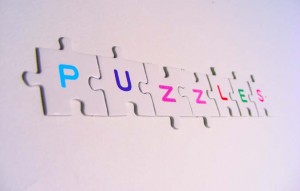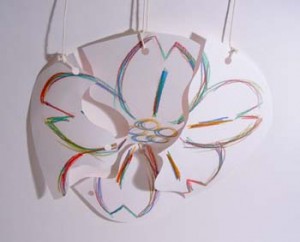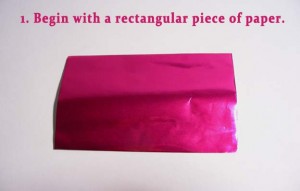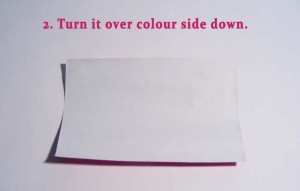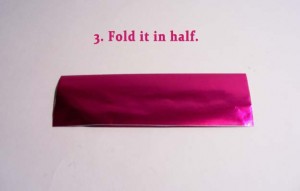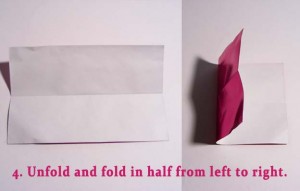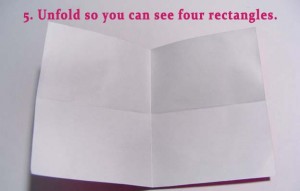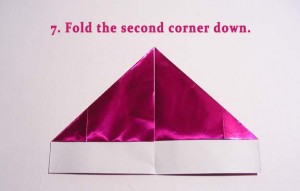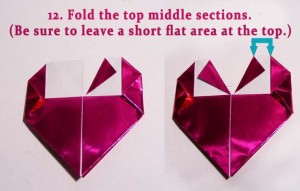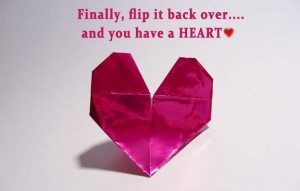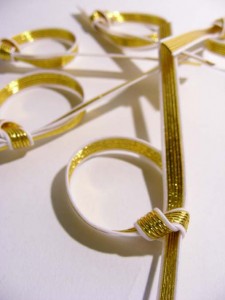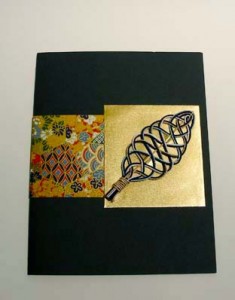Origami and Kirigami Mobiles
***Quite busy these days, but the pictures will be posted at some point in the future!***
Origami is a great method to create interesting and intricate looking decorations, very fun mobiles for children, or even outdoor wind chimes.
Origami can use any paper, or even fabric, it all depends on the model and function.
My favorite paper is chiyogami or light washi, but I have used many others like tissue paper, old wrapping paper, cardboard paper, magazines, brochures and even parchment paper.
When using chiyogami and washi, they are lovely for special decorations or additions to gifts since they vary in colour, pattern and texture.
They are great for origami mobiles and if properly sealed, outdoor creations as well.
To begin, decide which origami shape, and how many of them you would like.
Then choose the paper you would like.
If it’s for a baby’s mobile, sharp, contrast works best, so black and white patterns are a good choice.
For outdoor wind chimes, a thicker waxy paper would work well, but chiyogami and washi are also great choices as long as you use a waterproof sealer.
The size of the paper is your choice, the average origami sheets come in 15cm x 15cm squares, but you can cut that into quarters and make mini origami pieces, or just buy small pre-cut packs of origami.

Personalized Puzzles
For many occasions and parties, it’s fun to give out little gifts or prizes to the guests (or just the children).
This is simply an other little extra detail to your party planning that shows you appreciate your guests or just want to give them a keepsake.
Gifts and keepsakes don’t have to be expensive, they can simply be fun. For example, a favorite of mine is puzzles.
There are places that sell blank puzzle sets, where you can use almost anything to create you own personal puzzle. If you don’t want to purchase a blank puzzle set, just make your own with cardboard. This allows you to choose the size and shape of your puzzle (ie. Cut out a heart shape…), and how many pieces to cut out.
When it comes to decorating them, I generally use marker because it has a bright and bold look, it’s waterproof, and also writes more precisely between the pieces.
I have used many puzzles for different occasions as special handcrafted addition to gifts.
For example:
Mother’s Day:
a puzzle with a large variety of flowers (her favorites) with a personalized written poem. I then broke up the pieces and attached them to her gift.
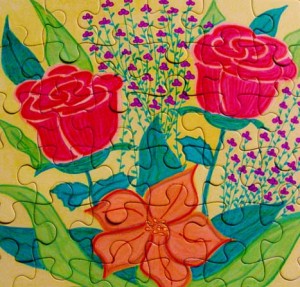
Birthday “guestbook” :
I drew in a big sign saying “Happy
Birthday!” along with stick figures in different poses or actions throughout the puzzle. I then had all the guests choose one stick figure representing them (or they could draw their own) and leave a little message.

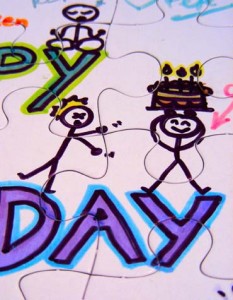
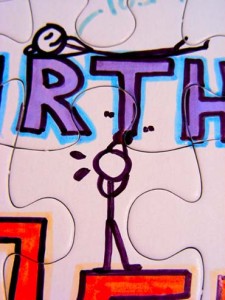
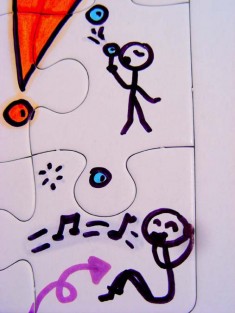
Card substitute:
I drew a representation of me and my best friend in a funny situation from when we were kids. I then broke up the pieces and mailed them in an envelope attached to her gift.
Games for children:
Many children love puzzles. Naturally, they shouldn’t be too complicated for the young ones, but challenging enough.
If you personalize the puzzles (draw the child or their favorite family member/friend/animal into the puzzle, or write their name) it will excite them about a game while they train their cognitive abilities and fine motor skills.
A set of letters for the older children will help them with their alphabet and spell out different words.

When I taught children (aged 3-5), I made large puzzles (60cm x 60cm or larger) and placed them in groups of four, or get bigger groups where everyone gets one puzzle piece.
They learn to work together where everyone pitches in for one complete puzzle.
If you would like to be even more creative, create a puzzle that has an image or words on both sides, then have the puzzle pieces hung in the appropriate order, but slightly spaced.
Mizuhiki
Mizuhiki is the traditional art of knot tying. The cords are made of tightly twisted paper and covered with gold thread or painted in an array of different colours.
This ancient art form began in the time of samurai, where it was used to tie their top knots, or even to decorate very special gifts.
Today, it’s used to decorate anything from stationery, gifts, decorations around the home, mobiles, hair decoration, interesting pieces of art (carp, cranes…) or anything else you can think of.
If you would like more resources about mizuhiki or would like to purchase some for a special occasion, please send me a message through my contact page.
Freebies for Art Projects
Today, we produce a lot of waste in our homes and at work from packages, junk mail, as well as products that have served a purpose and are no longer needed.
Many of these used and wasted materials can be used for projects to create practical or decorative items.
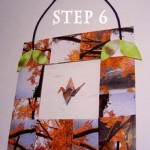
In previous posts, I’ve already shown how to make decorative frames and boxes from materials around your home.
If you ever have a project in mind and require materials like cardboard or decorative paper, unless it’s a specialized project, you can use a lot of the free materials that are available.
There are many things we have around the home that can be quite useful.
For example:
Cardboard:
- dried food packages
- old/used notebooks
- product packaging
Paper:
- flyers
- fast food restaurant
- menus
- brochures
- business cards
- wrapping paper
- maps
- holiday cards
- newspapers/magazines
- mail/money envelopes
String:
- packaging string
- sewing thread
- yarn
- shoelaces
- hair ties
- boxer elastics
- old clothes/socks/bag straps
Extras:
- colourful pens
- paints
- markers
- nail polish
- old/broken jewelry
- anything old or torn
- anything with decorative bits and pieces.
Besides our homes, there are many other places that will have freebies.
With many of my eco projects, I use various materials that I have at home, or happen to receive (usually from people who stand outside handing out flyers).
Other places that I’ve noticed for freebies are:
Supermarkets:
newspapers, magazines, flyers, brochures, boxes, bags, foam, paper
Banks:
Brochures, envelopes, carbon paper (if you make a mistake on a form)
Train/ Bus Stations:
Flyers, brochures, free magazines & newspapers
Cafes:
Brochures, paper food bags, tissues, wooden stir sticks, mini spoons, sugar packets & mini cream containers (after use), plastic straws
Fast Food Restaurants:
Plastic straws, tissues, paper tray covers, sugar packets and mini cream containers (after use), plastic utensils, wooden stir sticks, brochures, flyers,
Museums and Art Galleries:
Lots of reading materials, advertisements, brochures, free magazines, postcard ads, flyers (all will usually have colourful or interesting images)
Book Shops / Music Shops:
Free magazines, catalogues, flyers, ads
Department Stores/Shopping Malls:
Flyers, free samples, brochures, free magazines, newspapers


